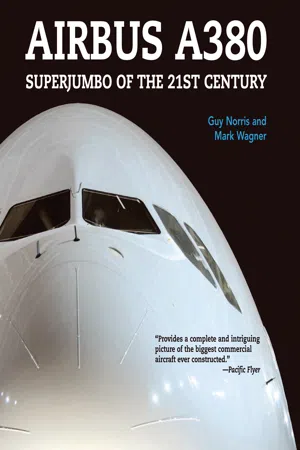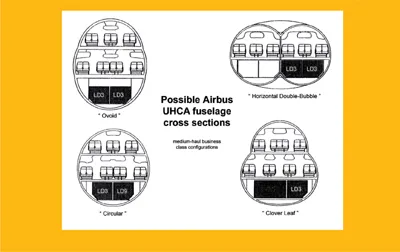![]()
1
Back to the Roots
As Jean Roeder was presenting his plans for the future, development work was underway on the Airbus A330 and A340, the largest airliners yet designed in Europe. They, in turn, traced their ancestry directly back 20 years to the first Airbus product, the A300. Developed as the world’s first wide-bodied twinjet, the A300 was the product of a European study into a new “air bus” to link major hubs such as London and Paris.
The study was the work of an Anglo-French government working group that encapsulated its findings in a 1965 report, “Outline Specification for the High-Capacity Short-Haul Aircraft.” This formed the DNA for what was to become Airbus Industrie, the French-based European consortium formally established in December 1970 to challenge the dominance of American commercial jet makers.
Although it was a notable engineering achievement, the A300 failed to impress many of the world’s airlines when it first flew in October 1972. With very slow sales, the big twin limped almost unnoticed through the early 1970s. The giant U.S. aircraft manufacturers scoffed at it, and the global recession that the oil crisis in the Middle East sparked severely hampered it. These were dangerously vulnerable years for Airbus, which held onto life by a thread, selling only a single aircraft in 1976 and producing only one aircraft per month.
But airlines that were forced to adjust to higher fuel prices in the late 1970s gradually recognized the economic appeal of a wide-body twin. The basic concept of a large twin, ironically, had come from an early American Airlines specification, and it was a U.S.-based carrier, Eastern Airlines, that provided the sales breakthrough. The April 1978 order for 23 A300B4s by Eastern, the first North American customer for Airbus, instantly gave the fledgling manufacturer a new measure of credibility that it has kept to this day. It’s interesting to note that the original American specification also led directly to the birth of the DC-10 and the L-1011—both trijets. Eventually, in 1987, American Airlines did order a fleet of A300-600Rs, which served it well into the twenty-first century.
![]()
Studies Begin
It was the inherent flexibility of the basic A340 fuselage that Roeder seized on for the new UHCA project in late 1988. “The purpose was to try and do something at the lowest possible cost by using as much as we could from the existing products. When I presented the original project to Pierson, it was all based on what we could afford.”
Wolf-Dieter Wissel, who Roeder appointed to lead the UHCA study project and who would ultimately become the director of configuration integration for the A380, said: “It all came from first ideas on a piece of paper, almost on the back of an envelope, if you like. To be honest, it was all a bit like a dream, there was nothing available from which to start. But one of Roeder’s brilliant ideas was to use the A340 design elements to create this horizontal double-bubble [HDB] concept. We took the A340 fuselage and sort of stretched the fuselage laterally and put the A340 wings on it and used slightly larger versions of the HTP [horizontal tailplane] and both vertical tails.”
The bizarre-looking concept was sized to be about 20 percent larger than the 747-400, and could therefore seat up to 517 in a three-class configuration. A flight deck was perched cupola-style atop the fuselage. The Airbus technical director at the time, Bernard Ziegler, was also keen to emphasize the possibilities of a clean-sheet design. “We’ve got to think about a wider fuselage. We get no lift at all from the fuselage today,” he said when details of the design began to emerge.
![]()
Adaptability and innovation were hallmarks of the Airbus heritage, largely driven by the need to do more with less. The use of a common wing on both the twin-engined A330 and the four-engined A340 was a key enabler to making the entire project affordable. The outboard engine on the A340 is located adjacent to the gap between the outer flap section and the inboard edge of the aileron, and provides wing bending relief moment to the structure of the longer-range variants. The inboard engine is sited at the same location as the engine on the A330, pictured here on the -200 demonstrator during a flying display at the 2000 Farnborough Air Show. Externally, the only difference between the two wings is a split between the fourth and fifth leading edge slat on the A340 wing. Mark Wagner
![]()
Pierson and Flosdorff had given Roeder the go-ahead to continue with studies, and the Airbus supervisory board gave its official approval for further evaluations after Roeder’s first formal presentation to them in June 1990. With that approval, Airbus decided to gingerly put its toe in the market with the concept at the 1990 Farnborough Air Show that time between 2003 and 2005. Airbus set a goal of having direct operating costs that were at least 15 percent lower than the operating costs of the 747-400, though Jean Pierson told Flight International in May 1991 that the development would take account of “the improvements they [Boeing] will make to the 747 by the year 2000 . . . our obligation is to offer something to the market that is far better than that.”
With so much at stake, and with the need to focus on specific new support technologies for a UHCA, Airbus and its four partners launched a joint technology program. This new partnership was formed under the auspices of the European 3E (environment, economy, energy) technology effort originally organized by Airbus, its partners, and the European governments in the late 1980s to coordinate and rationalize research efforts.
In this case, the new initiative was directed at defining three new technology demonstration platforms for the single-aisle A320-size class, one for the A340-size category, and one in the 500-seat arena.
This novel approach ensured that Airbus would utilize the best ideas and technologies from throughout Europe by organizing four pre-project teams from its partners—Aerospatiale, Deutsche Aerospace (DASA), British Aerospace, and Construcciones Aeronáuticas, SA (CASA). The plan directed the four teams to effectively compete with different designs to be presented to the Airbus supervisory board by early 1992. The board would then select one or two of the most competitive designs, and if none were sufficiently cost-competitive with the 747 they would have to go back to the drawing board. “We were expecting we would need new technology to meet the range and weight targets. We knew it could not be done using the existing technology of those days; that was clearly understood,” said Wissel.
Airbus remained confident, however, that one or more of the teams would come up with a world-beater, or at least a design that could be merged with features of the other contestants and possibly even those of the in-house concepts. This would then allow the concept to be formally adopted in 1993 in preparation for a launch in 1996 or 1997. At this stage, Airbus planned to begin searching for risk-sharing partners and estimated that the overall development cost would be in the $4 to $5 billion range—an enormous amount of money that would eventually form less than half of the new airliner’s final cost.
![]()
Designing the A340, the consortium’s first four-engined model, taught Airbus valuable lessons that would be used to good effect when developing the structural and systems redundancy of the A380. It also shared a common cockpit with the A330 and helped establish the principle of crew cross-qualification, which enabled pilots to quickly transition not only between the big twin and its quad sister ship, but also between these larger aircraft and the A320. Total orders for the CFM International CFM56-5C-powered A340-200/300 family topped 240 by mid-2005. Mark Wagner
![]()
A bigger wing and more powerful Rolls-Royce Trent 500 turbofans rejuvenated the A340 and, with the 380-passenger -600 version in particular, gave Airbus the ability to take on the 747 for the first time. The development allowed the model to penetrate two Boeing strongholds—ultra-long range and high capacity—though the shorter bodied -500 faced massive competitive pressure from the twin-engined 777-200LR. With combined orders of about 140 by mid-2005, the duo spearheaded the Airbus attack on the upper end of the “fragmented” point-to-point market. Mark Wagner
![]()
Airbus’ first publicly revealed UHCA concept was an unusually configured aircraft with a wide fuselage made up of two A340 fuselages melded side by side. The idea was the brainchild of Roeder, who believed the use of existing A340 components, including wings, tails, and other systems, would be the only way to afford to attempt such an ambitious project. The concept got as far as the wind tunnel stage but did not produce encouraging results. Airbus
![]()
Nearly everyone in the airliner industry agrees that the most important design decision in the history of any jetliner is the cross section. With no option but to go for a clean-sheet configuration, Airbus studied everything from a giant circular section, which limited the upper deck options, to a “clover leaf” design that provided optimum space but was less aerodynamically and structurally efficient. Top right is the famous A340-derived horizontal double-bubble section, while the “ovoid” cross section finally adopted is pictured top left. Airbus
![]()
Personally thanked by French President Jacques Chirac for his decisive role in launching the A380, former Airbus President Jean Pierson is pictured during the early 1990s at the beginning of the UHCA odyssey. His aim from the start was to take the 747 head-on, and more particularly any upgraded variant. “Our obligation,” he said, “is to offer something to the market that is far better than that.” Mark Wagner
![]()
Reacting to the booming traffic growth across the Pacific in the late 1980s and early 1990s, United issued a broad specification to Boeing in 1991 for a UHCA aircraft dubbed the N650. It established the baseline size at between 600 and 700 seats and pushed Boeing’s studies up in size well beyond the 415-seat 747-400. The larger size category of the United spec would later drive an insurmountable wedge between Boeing and the European partners during the abortive very large commercial transport (VLCT) joint studies. Mark Wagner
![]()
A key driver behind the twin-engined wide-body concept adopted by Airbus for the A300B was based on a 1966 requirement for an “air bus” issued by American Airlines. Nicknamed the “Kolk Machine,” after American’s engineering vice president, Frank Kolk, who crafted the specification, the idea later morphed into a trijet and bizarrely led to the birth of not only the big twin, but also to that of the two big trijets, the McDonnell Douglas DC-10 and Lockheed L-1011 TriStar. American eventually would operate both the A300 (as the -600R variant) and the DC-10, one of which is pictured on takeoff from Las Vegas McCarren International in 1989. Note the pair of ex-Eastern L-1011s in storage close to the corner of the field where the Luxor pyramid-shaped hotel now stands. Mark Wagner
![]()
Interim developments of the A300, including the A310 and the A300-600, were followed in 1980 by an expansion into the single-aisle, short-haul market with the A320. The diversification helped strengthen the industrial base of Airbus at a grassroots level beyond Europe, and just as importantly established the manufacturer’s reputation across a much broader range of airlines and operators.
Airbus based all its wide-body designs on the same 18-foot, 6-inch diameter fuselage cross section of the first A300. The fuselage was perfectly circular and provided enough width to accommodate two LD3 containers (the industry standard for cargo shipping) to be housed side-by-side in the lower cargo hold.
Satisfied with the logic of its cross section, which has frequently been identified as the most important specification in any new passenger aircraft design, Airbus always intended to stick with this platform for future higher-capacity designs.
Two of these original projects were designated A300B9 and A300B11. After the A320 launch, they were renamed TA9 and TA11, respectively, to indicate that they were twin-aisle projects. The TA9 was essentially a stretched A300 with more powerful engines for medium stage lengths, while the TA11 was to be the first Airbus design powered by four engines for long-haul routes. Even at this stage, however, Airbus did not presume to tread on the toes of Boeing and invade the sacred territory of the 747. The TA11 was simply aimed at replacing the 707 and DC-8 on long, thin routes which, although covering vast distances, were not sufficiently busy to fill an aircraft the size of the 747. Studies into the TA9 and TA11 continued into the 1980s under the leadership of Jean Pierson, but the big question of which one Airbus should launch remained.
The breakthrough, in terms of affordability, came when Roeder, then Airbus chief engineer, hit upon the idea of using the same wing for both designs. The aircraft already shared common fuselages, systems, flight decks, and tails, so the idea...









